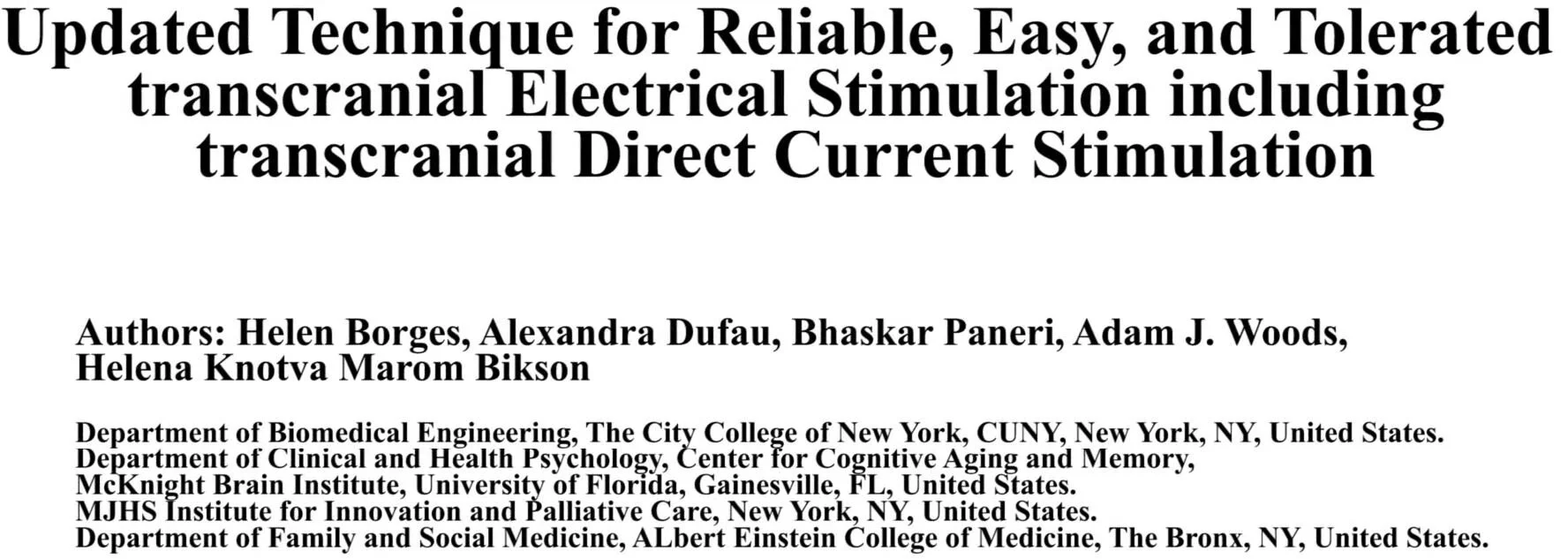Borges H, Dufau A, Paneri B, Woods AJ, Knotkova H, Bikson M. Updated Technique for Reliable, Easy, and Tolerated Transcranial Electrical Stimulation Including Transcranial Direct Current Stimulation. Journal of Visualized Experiments 2020. https://doi.org/10.3791/59204.
Niranjan Khadka, Helen Borges, Bhaskar Paneri, Trynia Kaufman, Electra Nassis, Adantchede L. Zannou, Yungjae Shin, Hyeongseob Choi, Seonghoon Kim, Kiwon Lee, Marom Bikson. Adaptive current tDCS up to 4 mA. Brain Stimulation. 2019 Jan;13(1):69–79. https://doi.org/10.1016/j.brs.2019.07.027
Download: PDF published in Brain Stimulation — DOI
Abstract
Background: Higher tDCS current may putatively enhance efficacy, with tolerability the perceived limiting factor.
Objective: We designed and validated electrodes and an adaptive controller to provide tDCS up to 4 mA,while managing tolerability. The adaptive 4 mA controller included incremental ramp up, impedance-based current limits, and a Relax-mode where current is transiently decreased. Relax-mode was automatically activated by self-report VAS-pain score>5 and in some conditions by a Relax-button available to participants.
Methods: In a parallel-group participant-blind design with 50 healthy subjects, we used specialized electrodes to administer 3 daily session of tDCS for 11 min, with a lexical decision task as a distractor, in 5 study conditions: adaptive 4 mA, adaptive 4 mA with Relax-button, adaptive 4 mA with historical-Relax-button, 2 mA, and sham. A tablet-based stimulator with a participant interface regularly queried VAS pain score and also limited current based on impedance and tolerability. An Abort-button provided in all conditions stopped stimulation. In the adaptive 4 mA with Relax-button and adaptive 4 mA with historical-Relax-button conditions, participants could trigger a Relax-mode ad libitum, in the latter case with incrementally longer current reductions. Primary outcome was the average current delivered during each session, VAS pain score, and adverse event questionnaires. Current delivered was analyzed either excluding or including dropouts who activated Abort (scored as 0 current).
Results: There were two dropouts each in the adaptive 4 mA and sham conditions. Resistance based current attenuation was rarely activated, with few automatic VAS pain score triggered relax-modes. In conditions with Relax-button option, there were significant activation often irrespective of VAS pain score. Including dropouts, current across conditions were significantly different from each other with maximum current delivered during adaptive 4 mA with Relax-button. Excluding dropouts, maximum current was delivered with adaptive 4 mA. VAS pain score and adverse events for the sham was only significantly lower than the adaptive 4 mA with Relax-button and adaptive 4 mA with historical-Relax-button. There was no difference in VAS pain score or adverse events between 2 mA and adaptive 4 mA.
Conclusions: Provided specific electrodes and controllers, adaptive 4 mA tDCS is tolerated and effectively blinded, with acceptability likely higher in a clinical population and absence of regular querying. Indeed,presenting participants with overt controls increases rumination on sensation.
Bikson M, Esmaeilpour Z, Adair D, Kronberg G, Tyler WJ, Antal A, Datta A, Sabel BA, Nitsche MA, Loo C, Edwards D, Ekhtiari H, Knotkova H, Woods AJ, Hampstead BM, Badran BW, Peterchev AV. (2019). Transcranial electrical stimulation nomenclature. Brain Stimulation. https://doi.org/10.1016/j.brs.2019.07.010 PDF
Abstract
Transcranial electrical stimulation (tES) aims to alter brain function non-invasively by applying current to electrodes on the scalp. Decades of research and technological advancement are associated with a growing diversity of tES methods and the associated nomenclature for describing these methods. Whether intended to produce a specific response so the brain can be studied or lead to a more enduring change in behavior (e.g. for treatment), the motivations for using tES have themselves influenced the evolution of nomenclature, leading to some scientific, clinical, and public confusion. This ambiguity arises from (i) the infinite parameter space available in designing tES methods of application and (ii) varied naming conventions based upon the intended effects and/or methods of application. Here, we compile a cohesive nomenclature for contemporary tES technologies that respects existing and historical norms, while incorporating insight and classifications based on state-of-the-art findings. We consolidate and clarify existing terminology conventions, but do not aim to create new nomenclature. The presented nomenclature aims to balance adopting broad definitions that encourage flexibility and innovation in research approaches, against classification specificity that minimizes ambiguity about protocols but can hinder progress. Constructive research around tES classification, such as transcranial direct current stimulation (tDCS), should allow some variations in protocol but also distinguish from approaches that bear so little resemblance that their safety and efficacy should not be compared directly. The proposed framework includes terms in contemporary use across peer-reviewed publications, including relatively new nomenclature introduced in the past decade, such as transcranial alternating current stimulation (tACS) and transcranial pulsed current stimulation (tPCS), as well as terms with long historical use such as electroconvulsive therapy (ECT). We also define commonly used terms-of-the-trade including electrode, lead, anode, and cathode, whose prior use, in varied contexts, can also be a source of confusion. This comprehensive clarification of nomenclature and associated preliminary proposals for standardized terminology can support the development of consensus on efficacy, safety, and regulatory standards.




